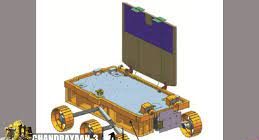
Chandrayaan-3’s Pragyan Rover Confirmes Sulphur Presence On The Surface Of Moon: The Indian Space Research Organisation (ISRO) said in a breakthrough announcement that Chandrayaan-3’s Pragyan rover module has successfully confirmed the presence of sulphur (S) on the Moon’s surface. This significant revelation comes as a result of the first-ever in-situ recordings conducted near the lunar south pole. The confirmation of sulphur’s presence holds paramount importance in unraveling the Moon’s elemental composition and furthering our understanding of its geological history.
Daily Current Affairs Quiz: August 2023
Laser-Induced Breakdown Spectroscope (LIBS) Instrument Provides Unambiguous Confirmation
According to ISRO, the Laser-Induced Breakdown Spectroscope (LIBS) instrument onboard the Pragyan rover found the presence of sulphur on the lunar surface near the south pole. This achievement marks the first time that in-situ measurements have been used to confirm sulphur’s existence on the Moon. LIBS operates by exposing a material’s surface, such as soil or rock bed, to high-energy laser pulses. The resulting high-temperature plasma is collected and analyzed using instruments like Charge Coupled Devices (CCDs).
Diverse Elemental Composition Unveiled by Pragyan Rover’s LIBS Instrument
In addition to sulphur, Pragyan rover’s LIBS instrument has identified several other elements present on the lunar surface. Aluminium (Al), calcium (Ca), iron (Fe), chromium (Cr), titanium (Ti), manganese (Mn), silicon (Si), and oxygen (O) are among them. The presence of aluminium, sulphur, calcium, iron, chromium, and titanium has been visually portrayed in preliminary analyses. Further measurements have revealed the presence of manganese, silicon, and oxygen. ISRO is actively conducting a thorough investigation into the presence of hydrogen as well.
India’s Unique Position and Lunar Exploration Advancements
Anil Bhardwaj, the director of the Physical Research Laboratory, emphasized India’s advantageous position as the first country to successfully land near the Moon’s south pole on August 23. Bhardwaj highlighted that this achievement puts India in a pivotal role to collect groundbreaking data for the first time. The focus is on maximizing data collection efforts before the lunar sunset.
Mission Timeline and Prospects for Extension
The Chandrayaan-3 mission is scheduled to continue until September 6, a date corresponding to the Moon’s sunset. However, ISRO chairman S Somanath hinted at the possibility of extending the mission if the equipment proves resilient to the Moon’s low temperatures during the lunar night and can recharge itself once the Sun rises again on the lunar surface.
LIBS: Technology Behind the Discovery
The Laser-Induced Breakdown Spectroscope (LIBS) technology responsible for these groundbreaking findings was developed at the Laboratory of Electro-Optics Systems (LEOS), a unit within ISRO. LEOS is a company that specialises in the design, development, and manufacturing of attitude sensors for missions in low earth orbit (LEO), geostationary equatorial orbit (GEO), and interplanetary space.
Chandrayaan-3’s Objectives
Chandrayaan-3, a follow-up to the 2019 Chandrayaan-2 mission, has three primary objectives.
- First, it aims to successfully demonstrate a safe and soft landing on the lunar surface—a goal that eluded Chandrayaan-2.
- Second, the mission seeks to showcase the rover’s ability to navigate the lunar landscape.
- Third, Chandrayaan-3 aims to conduct in-situ scientific experiments, leveraging cutting-edge technologies to uncover new insights into the Moon’s composition and history.
As the Chandrayaan-3 mission continues its exploration journey, the insights gained from Pragyan’s discoveries promise to reshape our understanding of Earth’s natural satellite, opening new avenues for lunar research and space exploration.





